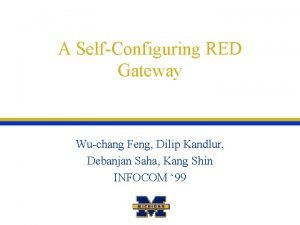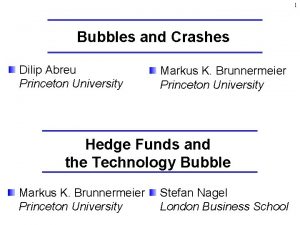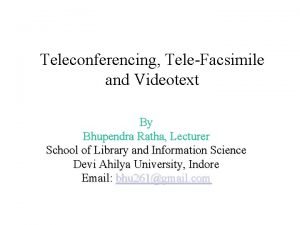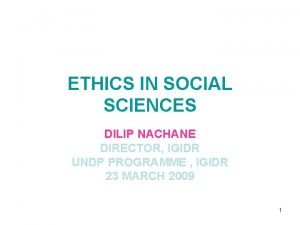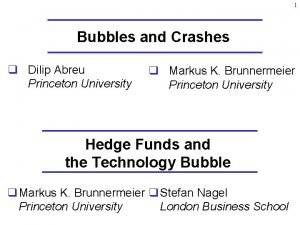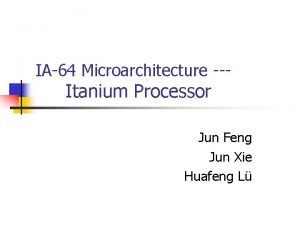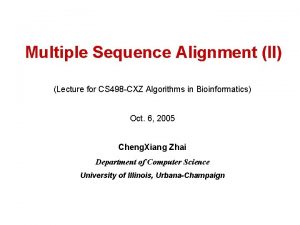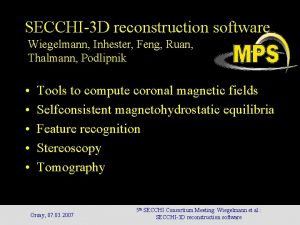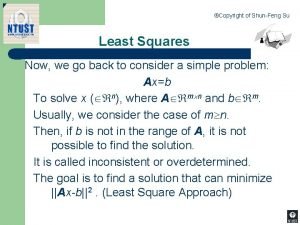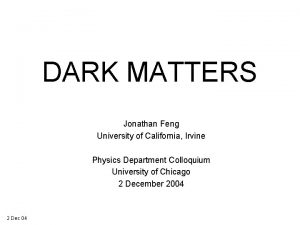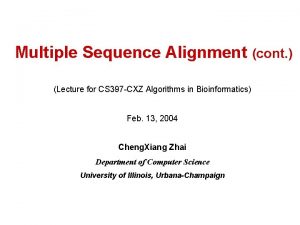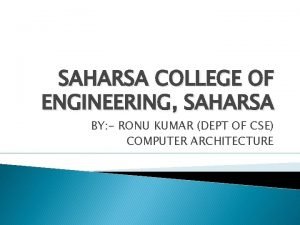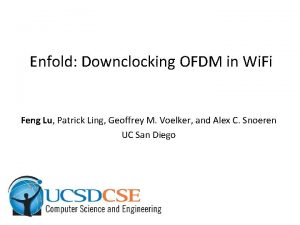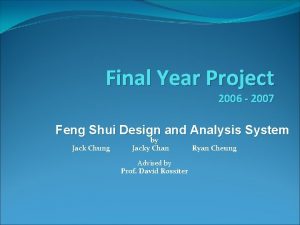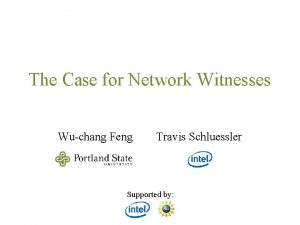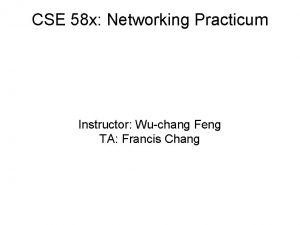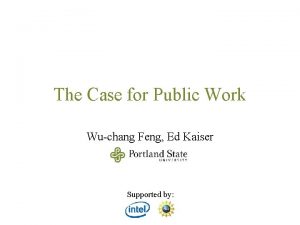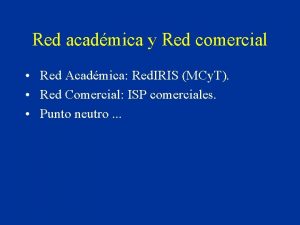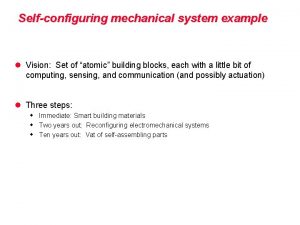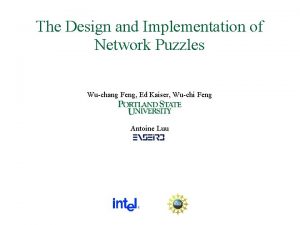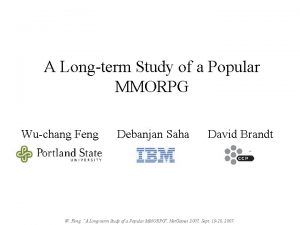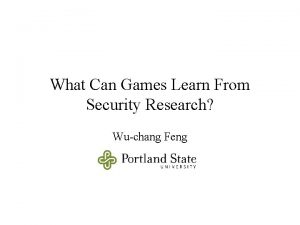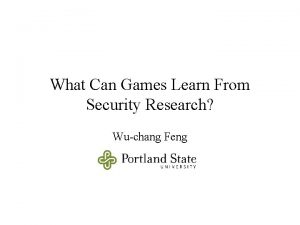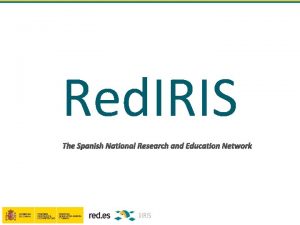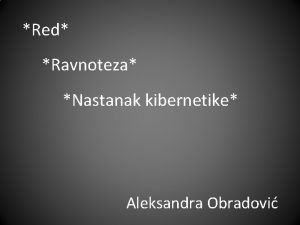A SelfConfiguring RED Gateway Wuchang Feng Dilip Kandlur






![RED Queue Management • RED (Random Early Detection) [Floyd 93] – Keep EWMA of RED Queue Management • RED (Random Early Detection) [Floyd 93] – Keep EWMA of](https://slidetodoc.com/presentation_image_h/1b8f9d86ecb0b7c1b51e9815d8a9e48e/image-7.jpg)




![Comments on Model • • Reducing N - [Balakrishnan 98] Increasing RTT - [Villamizar Comments on Model • • Reducing N - [Balakrishnan 98] Increasing RTT - [Villamizar](https://slidetodoc.com/presentation_image_h/1b8f9d86ecb0b7c1b51e9815d8a9e48e/image-12.jpg)













- Slides: 25

A Self-Configuring RED Gateway Wu-chang Feng, Dilip Kandlur, Debanjan Saha, Kang Shin INFOCOM ‘ 99

Outline • • • Motivation Background (TCP, Drop-tail, RED queue management) RED, packet loss, and ECN Adaptive RED Conclusion

Motivation • Exponential increase in network demand – Rise in packet loss rates • 17% loss rates reported [Paxson 97] – Decrease in link utilization and goodput – Two essential ingredients for congestion collapse [Jacobson 88]

Congestion Control Today • TCP – Instrumental in preventing congestion collapse – Limits transmission rate at the source – Window-based rate control • Increased and decreased based on implicit signals from the network (acknowledgments and packet loss) • Slow-start • Fast-retransmit, Fast-recovery • Congestion avoidance

Example of TCP Windowing Congestion avoidance Fast Retransmit/Recovery Slow-start 2 W 4 W+1 W 2 1 RTT RTT

Random Early Detection • Drop-tail queue management – – – Default queue management mechanism Packets dropped upon queue overflow Global synchrony Poor link utilization Excess packet loss due to late congestion notification Potentially large queuing delay • RED – Randomize congestion notification – Early detection of incipient congestion
![RED Queue Management RED Random Early Detection Floyd 93 Keep EWMA of RED Queue Management • RED (Random Early Detection) [Floyd 93] – Keep EWMA of](https://slidetodoc.com/presentation_image_h/1b8f9d86ecb0b7c1b51e9815d8a9e48e/image-7.jpg)
RED Queue Management • RED (Random Early Detection) [Floyd 93] – Keep EWMA of queue length (Qave) – Increase in EWMA triggers random drops • Basic algorithm 1 Pdrop maxp 0 maxth minth Qave

This Work • Without ECN – RED has minimal effect on packet loss • With ECN – RED has a hard time • Avoiding packet loss • Avoiding under-utilization • Avoiding global synchrony • Controlling queuing delay • Problem – RED is not adaptive to congestion • A solution – Adaptive RED

RED and Packet Loss • Impact of RED on loss rates minimal • Experiment – 64 connections over full-duplex Ethernet links – Simulated in ns – Verified over smaller Free. BSD/ALTQ testbed 100 Mbs 10 Mbs

RED and Packet Loss rates are a first order function of TCP

TCP Revisited 1/p = W + (W+1) + … + 2 W = 3 W 2/4 BW = MSS*(3 W 2/4) = MSS*C = L RTT*(W/2) RTT*sqrt(p) N p = N * MSS * C L * RTT 2 2 W 4 W+1 W 2 1 RTT W/2 RTTs
![Comments on Model Reducing N Balakrishnan 98 Increasing RTT Villamizar Comments on Model • • Reducing N - [Balakrishnan 98] Increasing RTT - [Villamizar](https://slidetodoc.com/presentation_image_h/1b8f9d86ecb0b7c1b51e9815d8a9e48e/image-12.jpg)
Comments on Model • • Reducing N - [Balakrishnan 98] Increasing RTT - [Villamizar 94] Decreasing MSS - [Feng 98] Loss rates as a function of N between linear and quadratic – Fair share assumption (L/N) - [Morris 97] – No retransmission timeouts - [Padhye 98] p = N * MSS * C L * RTT 2

ECN • Without ECN, packet loss rates will remain high • IETF ECN WG (1998) • RFC 2481 - January 1999 (Experimental standard) – 2 -bits in “DS Field” of IPv 4/IPv 6 headers (ECT, CE) – 2 -bits in “TCP Flags” field of TCP (CWR, ECN Echo)

RED and Packet Loss • Even with ECN, RED does not eliminate packet loss • Problem – RED is not adaptive to congestion level – maxp constant • Congestion notification vs. number of connections – N = number of connections – Offered load reduced by [1 - (1/2 N)] per notification

RED Experiments • 8 or 32 TCP sources using ECN • Conservative vs. aggressive early detection • Simulated in ns – Aggressive detection: maxp = 0. 250 – Conservative detection: maxp = 0. 016 100 Mbs 10 Mbs 45 Mbs RED queue (minth=20 K, maxth=80 K, Qsize=80 K)

Aggressive Early Detection 8 sources 32 sources

Conservative Early Detection 8 sources 32 sources

Conservative Early Detection 32 sources, Qlen = 120 KB

Adaptive RED • • Adapt maxp based only on queue behavior (not N) Increase maxp when Qave crosses above maxth Decrease maxp when Qave crosses below minth Freeze maxp after changes to prevent oscillations 1 Pdrop maxp 0 maxth minth Qave

Evaluation • Workload varied between 8 and 32 sources 100 Mbs 10 Mbs 5 ms 100 ms 5 ms 1 ms 45 Mbs 5 ms RED queue (minth=20 K, maxth=80 K, Qsize=120 K)

Static Early Detection Aggressive Conservative

Adaptive RED Queue length maxp

Implementation • Free. BSD 2. 2. 6 + ALTQ • Ascend, Cisco 100 Mbs 233 MHz 128 MB 200 MHz 32 MB 200 MHz 64 MB 50 KB RED queue 166 MHz 32 MB

Adaptive RED Performance Loss rates Link utilization

Conclusion • Without ECN – RED does not impact packet loss rates • With ECN – RED still has trouble adapting to workload • Adaptive RED can improve performance • Future work – – – Deployment issues Tuning additional RED parameters Eliminating loss with Sub. TCP Influence on fairness extensions to RED http: //www. eecs. umich. edu/~wuchang/ared/
 Dilip kandlur
Dilip kandlur Dilip abreu
Dilip abreu Types of teleconferencing
Types of teleconferencing Dilip kumar
Dilip kumar Dilip ratha
Dilip ratha Dilip lift truck
Dilip lift truck Dilip nachane
Dilip nachane Dilip rahulan
Dilip rahulan Dilip abreu
Dilip abreu Dilip lift truck
Dilip lift truck Ia64 processor
Ia64 processor Feng doolittle algorithm
Feng doolittle algorithm Feng ruan
Feng ruan Meet kevin teachables
Meet kevin teachables Shun-feng su
Shun-feng su Cuatro pilares viento y agua
Cuatro pilares viento y agua Pupuk feng shou untuk ternak
Pupuk feng shou untuk ternak Wayne feng
Wayne feng Jonathan feng
Jonathan feng Feng doolittle algorithm
Feng doolittle algorithm Feng suave vpro
Feng suave vpro Feng's classification in computer architecture
Feng's classification in computer architecture Zuo-feng zhang
Zuo-feng zhang Feng lu
Feng lu Feng shui floor plan analysis
Feng shui floor plan analysis Feng guo symmetry
Feng guo symmetry
